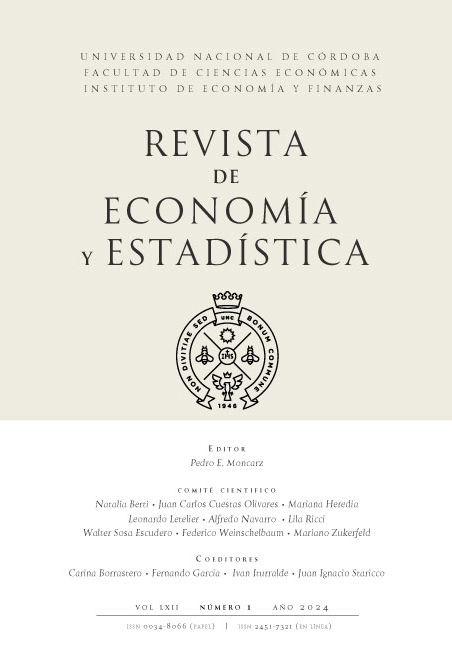Why do countries engage in the preferential trade agreement network?
DOI:
https://doi.org/10.55444/2451.7321.2024.v62.n1.46447Keywords:
Preferential trade agreements, NetworksAbstract
We analyze the determinants of Preferential Trade Agreements Networks dynamics. We propose a theoretical framework based in an extension of Baldwin (1995) to rationalize the determinants of PTA formation as a way to maximize preferential market access and/or diminish market discrimination. To build the empirical model we use a Stochastic Actor Oriented Models proposed by Snijders (2001). We suppose that three main set of variables will affect the countries motivation to change their PTA neighborhood at each moment. The first is related to natural trade cost and market size. The second group is related to political economy effects. And finally, we include a variable related to trade specialization, which has not been used in earlier works to explain PTAs. Following Snijders et al. (2012) we also control for hierarchy structures of the PTA, and we extend their work by analyzing the change in this phenomenon when considering a broader period of time. Results show that the signs of usual variables behave as expected in the literature for the first period but hierarchy effect dilutes after 2004. As a contribution to existing literature, we found that trade rivalry between countries is also significant in explaining the dynamics of PTA.
Reception date: 18/09/2024
Acceptance date: 05/12/2024
Downloads
References
Baier, S. L. and Bergstrand, J. H. (2017). Data Construction Methodology. Unpublished manuscript. Kellog Institute.
Baier, S. L. and Bergstrand, J. H. (2004). Economic determinants of free trade agreements. Journal of International Economics, 64(1), 29-63.
Baier S. L., Bergstrand, J. H. and Mariutto, R. (2014). Economic Determinants of Free Trade Agreements Revisited: Distinguishing Sources of Interdependence. Review of International Economics, 22(1), 31-58.
Baldwin, R. E. (1995). A domino theory of regionalism. In Baldwin, R., Haaparanta, P. and Kiander, J. (Eds.), Expanding Membership of the European Union (pp. 25-53). Cambridge University Press.
Bergsten. C. F. (1996). Competitive liberalization and global free trade: A vision for the early 21st century. Peterson Institute for International Economics, Working Papers No. 96-15.
Grossman, G. M. and Helpman, E. (1992). Protection for sale. National Bureau of Economic Research, Working Paper No. 4149.
Grossman. G. M. and Helpman, E. (1995). The politics of free-trade agreements. The American Economic Review, 85(4), 667-690.
Hidalgo, C. A., Klinger, B., Barabási, A. L., Hausmann, R. (2007). The Product Space Conditions the Development of Nations. Science, 317(5837), 482-487.
Krugman, P. (1991). The move toward free trade zones. In Policy Implications of Trade and Currency Zones. A Symposium Sponsored by the Federal Reserve Bank of Kansas City at Jackson Hole. Wyoming, August 22-24. 7-42.
Krugman, P. (1992). Regionalism vs. multilateralism: Analytical notes. World Bank and CEPR Conference on New Dimensions in Regional Integration. Washington. DC.
Manger, M. S., Pickup, M. A. and Snijders T. A. B. (2012). A Hierarchy of Preferences: A Longitudinal Network Analysis Approach to PTA Formation. Journal of Conflict Resolution, 56(5), 853-878.
Manger, M. S. and Pickup, M. A. (2016). The Coevolution of Trade Agreement Networks and Democracy. Journal of Conflict Resolution, 60(1), 164-191.
Mansfield, E. D., Milner, H. V. and Rosendorff, B. P. (2002). Why democracies cooperate more: Electoral control and international trade agreements. International Organization, 56(3), 477-513.
Ripley, R. M., Snijders, T. A. B., Boda, Z., Voros, A. and Preciado, P. (2017). Manual RSiena. University of Oxford: Departament of Statititics. Nuffield College. University of Groningen: Departament of Sociology.
Snijders, T. A. B. (2001). The Statistical Evaluation of Social Network Dynamics. Sociological Methodology, 31(1), 361-95.
Snijders, T. A. B. and Steglich, C. E. G. (2009). Statistical Modeling of Dynamics of Non-directed Networks. Unpublished manuscript. University of Groningen: ICS/Department of Sociology and University of Oxford: Department of Statistics.
Snijders, T. A. B. and Pickup, M. (2016). Stochastic Actor-Oriented Models for Network Dynamics. In Victor, J. N., Montgomery, A. H. and Lubell, M. (Eds.). The Oxford Handbook of Political Networks (pp. 221-248). Oxford University Press.
Downloads
Published
Issue
Section
License
Copyright (c) 2024 Flavia Rovira, Marcel Vaillant

This work is licensed under a Creative Commons Attribution-NonCommercial-NoDerivatives 4.0 International License.
Authors who have publications with this journal agree to the following terms:
Authors retain their copyright and grant the journal the right of first publication of their work, which is simultaneously subject to the Creative Commons Attribution-NonCommercial-NoDerivatives 4.0 International License that allows third parties to share the work provided that its author and first publication in this journal are indicated.
Authors may adopt other non-exclusive licensing arrangements for distribution of the published version of the work (e.g. depositing it in an institutional telematic archive or publishing it in a monographic volume) as long as the initial publication in this journal is indicated.
Authors are allowed and encouraged to disseminate their work via the Internet (e.g. in institutional telematic archives or on their website) before and during the submission process, which can lead to interesting exchanges and increase citations of the published work. (See The Open Access Effect)














